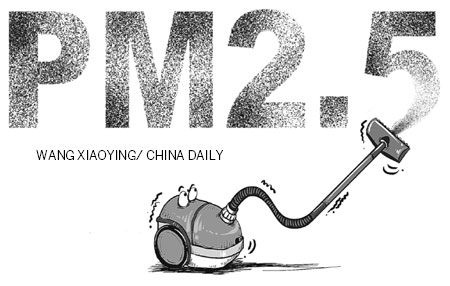London lessons to fight pollution in Chinese cities
One of the top issues on the agenda of the annual sessions of the National People's Congress and the Chinese People's Political Consultative Conference is how to improve the air quality in the country. The record levels of pollution in Chinese cities last week and the World Health Organization's concern over the situation are a stark reminder of the high cost China has paid for economic development.
China, however, can have more blue-sky days by emulating London's battle against the Great Smog of 1952 and the more recent battles against new forms of pollution caused primarily by motor vehicles in which transport management and technology have played significant roles.
The Great Smog of December 1952 is the severest pollution event to have affected London. A period of cold weather, combined with an area of high pressure and windless conditions, created airborne pollutants mostly from burning coal (used both by factories and homes) to form a thick layer of smog over London between Dec 5 and 9. The smog, according to government medical reports, caused the premature death of about 4,000 people and left nearly 100,000 ill. Recent research, however, suggests that the actual number of fatalities was far greater at about 12,000.
In 1956, the British government issued the Clean Air Act to create mandatory smokeless zones in residential areas both in towns and cities, where only authorized fuels could be used for cooking and heating. New regulations were implemented for the industry, too, restricting the use of dirty fuels and banning black smoke. Within just three years the use of coal disappeared from British cities, including London, where people could breath much more easily. Legislation can make a difference - a big difference. But transport management and technology also have important roles to play in the fight against air pollution, especially when the problem in London is not sulfur oxides but nitrogen oxides and PM2.5 (particulate matter with a diameter of 2.5 micrometer or less and extremely harmful to humans). To deal with the problem, a low emission zone was created across the whole of London. The idea was to reduce emissions from heavy and light goods vehicles.
London also imposes congestion charges on drivers, which was originally designed to deal with traffic congestion but has also helped reduce air pollution in central London hotspots. Both policy initiatives were pushed through by the previous London mayor in response to the pollution problem. And the present mayor wants to add an ultra low emission zone to encourage car manufacturers to develop vehicles with zero emissions at the tail pipe, though this is targeted to be operational in 2020.
Similarly, on my last trip to China, I saw Hong Kong had introduced electric cars with plug points and suitable parking lots. Such initiatives can be extended to other places quite easily once battery costs begin to drop. Technology too can play a greater role, not simply as an alternative to curbing environmental pollution but also to help mitigate its worst effects. A London-based architecture and design company, called Orproject, has plans to let Beijing residents breathe clean air in a park enclosed in a bubble. This would involve housing a botanical garden under a bubble dome-like structure, which could potentially cover office buildings, retail outlets as well as homes.
The air inside the bubble would be filtered before being pumped into the park and the buildings, which would have to be airtight. The bubble's roof is created by a computer algorithm that can generate and grow patterns that are based on those seen in leaves and butterfly wings. The co-founder of the project is in talks with developers and local government officials to make the idea a reality in Beijing and it is certainly something to watch out for in the bilateral relations between the British and Chinese capitals.
Chinese cities can take the lead in tackling this modern plague. The experience of the United Kingdom over the past 200 years is that rapid economic development can result in very damaging consequences for the environment and humans. But if the political leadership is strong and there is transparency between science, politics and the people, there is no reason why China cannot lead the other emerging economies in showing how growth and development can be made sustainable in the long term.
The benefits for human health would be considerable, the innovation and lessons learnt could be applied globally and the state would be able to guarantee one of the basic needs of human existence - access to clean, fresh air.
The author is the chair of the London Assembly Environment Committee.
 )
)

















